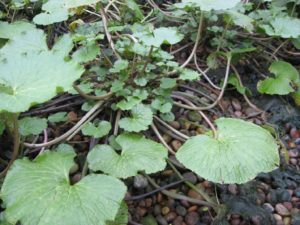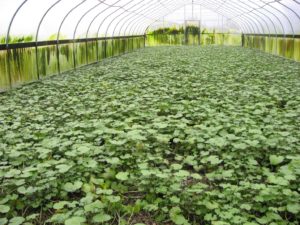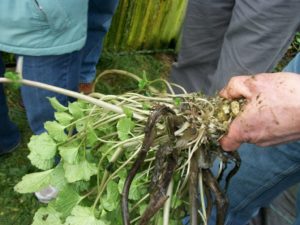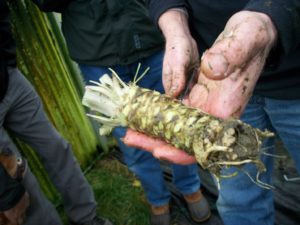It all started about 30 years ago. A sushi-loving woman in the Vancouver area wondered if wasabi could be grown locally.
Fortunately, she asked the right person: Brian Oates, who is now president and chief science officer of Pacific Coast Wasabi (PCW).
The answer? Yes. But not in the ways used in Japan, which are too water-intensive to make sense in the Pacific Northwest.
Oates says he didn’t know initially that growing wasabi in a greenhouse would be the ideal method. “That was all part of the trial and error,” he explains. “Our first growing opportunity in a backyard was basically just: can we grow it? So that was a long way from where we are now.”

Today, PCW’s greenhouse-grown wasabi is thriving. But, given its dependence on high-humidity growing conditions via a mist system, fungal pathogens might also thrive if growers don’t have access to effective fungicides. And because repeated use can cause fungal pathogens to develop resistance, alternating fungicides is critical for control — especially, in this case, of Pythium species.
That’s what makes the registration of mefenoxam, mobilized by IR-4, such welcome news to growers.
“Getting to know IR-4 was very, very helpful,” Oates states. “That work was valuable because it got us past one of the earlier pathogens. Had we not gotten through that, we probably wouldn’t have survived. There are other pathogens that we’re still dealing with, but [Pythium] was a roadblock to us.”
Oates also explains that, with this emerging industry, his team essentially had to encounter a pathogen before they could determine how to control it. “We may have tested a pathogen that wasn’t going to be part of the story,” he says. “We really had to go up to the roadblock and then fix it.”
The nature of PCW’s methods, meanwhile, keep them intimately aware of the crop’s condition.
“It’s all done by hand,” he explains. “We have nurseries, and the plants are in there for two to three months. Then they’re out-planted into the greenhouse. Our time from planting to harvest is 15 monthsplus.”
“Plus,” because they haven’t yet discovered a period when the plants become too big or too old. Demand is too great to postpone harvest.

The wasabi is processed in two different ways. It’s either freeze-dried and made into a powder, or it’s used fresh. “For fresh wasabi, basically, you just trim it with a knife, wash it with a hose and you’re done,” Oates says. “Then that product can go into the culinary market.”
Refrigerated, fresh wasabi can last for around six weeks. “It’s not like your typical vegetable,” he notes.
The culinary market, incidentally, is still largely dominated by fake wasabi. Nearly all of what is passed off as wasabi is actually green-tinted horseradish with a bit of hot mustard. Efforts are underway to clear up this confusion among consumers, but Oates acknowledges that this misconception is widespread and problematic for the industry.
Nevertheless, authentic wasabi has found a few surprising outlets.
“One of our biggest customers is in the cosmetics market,” Oates says. “We are the sole supplier of wasabi for Lush brand’s Wasabi Shan Kui shampoo. It’s very interesting.”
And very successful.
“It’s just a matter of keeping up with all of our customers,” Oates adds. “Basically, we are sold out every week right now.”
While the rhizome is primarily used in the culinary market, “the leaves are used as a garnish,” Oates says. “They’re also used as wraps and in all different aspects of the Japanese cuisine. The petioles are used in a product called wasabi zuke, which is a pickled wasabi. We sell a little bit to certain chefs who want to make their own.”
All parts of the plant may also have roles to play in the area of development most encouraging to Oates, which is biomedical research.

There’s been promising research around wasabi’s potential curative and health benefits. Plenty of interest in advancing that research exists, but currently, there isn’t enough wasabi being produced. “In Japan, they don’t have enough excess to develop any sort of supplement or biomedical market, so that’s where our focus is,” Oates explains.
“The Japanese are very interested in neurodegenerative diseases and treatment,” he continues, adding that the list of health issues that may be positively impacted by wasabi “kind of goes on and on. You might say, how can this one plant be responsible for so many benefits?”
PCW’s website lists numerous recent studies addressing that question. Oates’ more simplified version is essentially that “the bioactive molecules in wasabi activate Nrf2.”
In “Role of Nrf2 in Oxidative Stress and Toxicity,” Qiang Ma concludes, “Nrf2 has quickly emerged as a major regulator of oxidant resistance and has been implicated in a range of toxicities and chronic diseases that are characteristically associated with oxidative stress.”
That list of diseases is extensive — from cancer to multiple sclerosis to rheumatoid arthritis.
PCW’s freeze-dried wasabi has been incorporated into a supplement called Avmacol®, a “sulforaphaneproducing supplement,” according to its website. Sulforaphane has led to “substantially improved behavior” in some cases of autism, with further research underway.

And wasabi has been shown to help activate sulforaphane in anti cancer research.
So it’s easy to see why Oates is enthusiastic about increasing wasabi production — and about being able to control pathogens like Pythium as they emerge.
“Once the biomedical story gets more entrenched, it’s going to be very big,” he says. Additionally, “My speculation is that we’re going to see more restaurants say, ‘Oh we’d better start using the real thing.’”
And with better pathogen control thanks to IR-4, the real thing is more likely to flourish.
PR#10375 Wasabi (pythium)
Katie Chriest is a freelance technical writer in Erie, Pennsylvania; kmc503@psu.edu.
